
| KIT #: | 4806 |
| PRICE: | 2240 yen at HLJ |
| DECALS: | Two options |
| REVIEWER: | Scott Van Aken |
| NOTES: | Lifelike Decals 48-035 "Marseille Special". |

| HISTORY |
The Bf-109F Friedrich is considered aerodynamically to be the high point
of development of the Bf-109 series, in terms of harmony of airframe and engine
and overall performance. With the
failure of the Bf-209 and Bf-309 projects intended to replace the Bf-109, the
airframe continued in production with the Gustav and Kurfurst
series, with more weight and power added for only minor performance increases
other than top speed at altitude, and an increased service ceiling.
Shortly after the introduction of the Bf-109E into service,
Messerschmitt proceeded to design a major improvement to the Bf 109. The
new model was included structural and aerodynamic changes to take maximum
advantage of a higher performance powerplant, the 1,350 horsepower DB 601E.
Inserting the radiators deeper in the wings reduced drag and improved
lift. The engine cowling was streamlined with an enlarged spinner with the
propeller blades widened and shortened, while the wingtips were rounded and
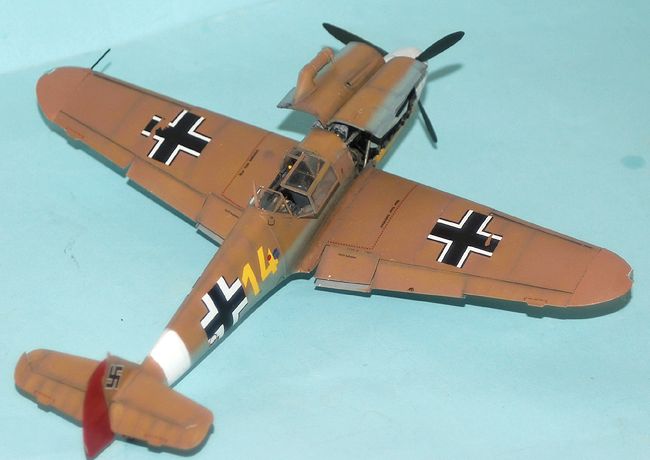 shorter-span ailerons were introduced, and the tail plane bracing struts were
removed. The V-21, V-22, V-23, and V-24 prototypes tested early versions of the
DB 601E engine, the new wings, and other changes.
shorter-span ailerons were introduced, and the tail plane bracing struts were
removed. The V-21, V-22, V-23, and V-24 prototypes tested early versions of the
DB 601E engine, the new wings, and other changes.
Armament was standardized on two fuselage-mounted 7.9mm machine guns and a 15mm
or 20mm cannon firing through the propeller shaft, based on combat reports that
the concentrated firepower of the fuselage guns was more effective than the
converging bullet streams from the wing guns on the Bf-109E.
Without the heavy cannons in the wings, handling characteristics were greatly
improved. The wings were always the
weak point of the Bf-109 design, and removing the guns allowed greater high-G
maneuvering without fear of wing failure that had been found in the Bf-109E.
When it was introduced to combat, the Bf-109F demonstrated superiority to
the new Spitfire V just being issued to RAF Fighter Command.
While Werner Molders advocated this new armament, Adolf Galland argued it was a
retrograde step, that the average Luftwaffe pilot needed the increased weight of
fire of the 20mm wing guns to give the margin of victory.
Galland was so adamant on this point that he continued to fly his
Bf-109E-4/N even after being given a Bf-109F-0, and did not fully adopt the
Friedrich until Messerschmitt provided him two Bf-109F-2/S one-off specials -
one with 13mm fuselage weapons and one with internally-mounted 20mm wing guns -
which he used through the second half of 1941 while he continued to command JG
26.
Due to delays in production of the 601E, delivery of the Bf 109F-0 and
Bf-109F-1, began in November 1940 with the aircraft still powered by the DB 601N
engine used in the Bf-109E-4 and E-7 and utilizing the MG-FF 20mm cannon.
Soon after their introduction, Luftwaffe units reported unexplained
losses, following violent vibrations and loss of control.
Examination of wreckage revealed that removing the tail bracing struts
without additionally strengthening the fuselage had caused the problem; this was
remedied by fitting reinforcing plates on the fuselage. The Bf 109F-2,
introduced in February 1941 differed from the F-1 with the introduction of the
MG 151 15mm cannon. In early 1942,
the DB 601E was finally installed in the Bf-109F-3 and the Bf-109F-4.
The F-3 continued use of the 15mm MG 151l like the F-2, while the F-4
introduced a larger MG 151 20mm cannon, self-sealing fuel tanks, and better
pilot armor.
The Bf-109F-4 was the ultimate Friedrich.; Weighing 6,880 pounds, it had a top
speed of 390 m.p.h. at 20,000 feet, with a service ceiling of 39,400 feet.
The Bf-109F-4/R6, introduced at the insistence of Adolph Galland after he
became General der Jagdflieger, carried a pair of MG 151s in underwing gondolas.
Handling was adversely affected and the R6 was limited to bomber
interceptor roles. The final
version was the Bf-109F-4/Trop, modified for use in North Africa.
The Bf-109F began disappearing on the Channel Front with the introduction of the
Focke-Wulf Fw-190A, while the aircraft continued in service on the Eastern Front
as late as mid-1943, due to its superior dog-fighting capabilities, being
replaced by the Bf-109G-2 there only when spares were no longer available.
 ust over 2,000 Bf-109Fs were produced
- 16% of the total Bf-109 production -
before being replaced by the 109G.
ust over 2,000 Bf-109Fs were produced
- 16% of the total Bf-109 production -
before being replaced by the 109G.
While the Bf-109F arrived just too late to take part in the Battle of Britain,
it was the main Luftwaffe fighter at the start of Operation Barbarossa. The
superiority of the Bf-109F to everything used by the Soviets other than the
Yak-1 allowed Luftwaffe pilots to run amazing scores during 1941 and 1942.
On the Channel Front, the Bf-109F allowed the Luftwaffe to maintain air
superiority over the RAF even with only two Jagdgeschwadern - JG 2 and JG 26 -
committed to the battle. In North
Africa, the Bf-109F was superior to every RAF fighter it opposed, and only the
increasing numerical superiority of the Allies in North Africa was able to
eventually overcome this superiority.
The Star of Africa - Hans Joachim Marseille:
Hans Joachim Marseille is considered the
most amazing, unique, and lethal ace of the Second World War.
His score of 158 victories, all achieved against the RAF, is unmatched by
any other Luftwaffe pilot. With an
average lethality ratio of just 15 shots per victory. Marseille was described by
Adolf Galland thus: "He was the unrivaled virtuoso among the fighter pilots of
World War Two."
Initially, Marseille was a
non-conformist in an organization that did not accept such behavior, and his
introduction to combat with JG 52 under Johannes Steinhoff during the Battle of
Britain was not a success, though on his third mission he shot down a Spitfire
and by the end of the Battle Of Britain had seven victories; he was also shot
down four times, while his behavior
on the ground got him in trouble, since he had such busy night life that on
occasion he was too tired to be allowed to fly the next morning. His love of
American Jazz music was an additional strike against him.
Following the Battle of Britain, he was returned to Germany, and there
was serious thought given to getting rid of him.
Fortunately, by the Spring of 1941, the Luftwaffe was stretched by its
involvement in the Mediterranean and North Africa, and young Leutnant Marseille
found himself "exiled" to North Africa with an assignment to I Gruppe,
Jagdgeschwader 27, the Luftwaffe unit assigned to the Afrika Korps for air
defense. There, the Geschwader
Kommodore, Oberstleutnant Eduard "Edu" Neumann, gave Marseille the opportunity
he needed.
With Neumann giving him the kind of support he needed, and with the lack of
"social alternatives" in the desert,
Marseille began to analyze his combat activity, began a personal program
to improve his abilities as a fighter pilot.
Marseille decided he would adapt his
eyes to the powerful desert sun and dry desert atmosphere, and adapt his body to
the desert conditions. He stopped wearing sun glasses, deliberately exposing his
eyes to the desert sun, and replaced alcohol with milk. He discovered that in
the intensely lit dry desert atmosphere, and aircraft could be detected from
greater distances than over Europe; from this he determined that ambush and
surprise were less practical over the desert than in the cloudy European sky.
 He also worked to strengthen his abdominal and leg muscles to enhance his
ability to sustain higher G-Forces for longer durations during dogfights than
the average fighter pilot. He
also took every opportunity to perform breathtaking aerobatics. In addition to
providing entertainment to his friends, these exercises also gave him
outstanding control and confidence in performing extreme maneuvers.
He also worked to strengthen his abdominal and leg muscles to enhance his
ability to sustain higher G-Forces for longer durations during dogfights than
the average fighter pilot. He
also took every opportunity to perform breathtaking aerobatics. In addition to
providing entertainment to his friends, these exercises also gave him
outstanding control and confidence in performing extreme maneuvers.
Finally, Marseille used his leftover
ammunition to practice firing at ground objects; additionally, he became a
master of high-deflection shooting
while in a sharp turn, which is the most difficult gunnery situation to control.
Given the air combat conditions of North
Africa, Marseille was able to fight alone with only a wingman. He claimed that
when fighting alone in a short range dogfight, he could fire at anything he saw,
while the attacked pilots were confused, leading them to hesitate and switch to
a defensive position that further increased the lone attacker's chances. His
preferred method of attack was to make high-angle deflection shots from short
range while in a sharp turn. He
never used his gunsight, instead firing a very short burst at the passing target
in the split second when its propeller disappeared behind his aircraft's nose.
He calculated that with a short burst at this position, the rounds would hit the
target's engine and cockpit. He
concluded that, over the desert, a fighter pilot can become "invisible" only by
in extreme maneuvers at close range, and that the intensity of the maneuvering
was more important than speed.
Marseille first demonstrated his new abilities on Sept. 24, 1941.
On a fighter sweep, he suddenly broke formation and flew off in a
direction where no one else saw anything. When his fellow pilots caught up with
him, he had already shot down a bomber. Later the same day, his formation of six
met 16 Hurricanes. As a junior
pilot, Marseille and his wingman were ordered to provide cover to the other
four, which attacked the Hurricanes.
After three Hurricanes were shot down, Marseille told his wingman to
cover him and attacked a formation of four Hurricanes passing below. He dove,
leveled at their altitude, and shot down two in a single burst while in a sharp
turn. He then dove to gain airspeed then zoomed back up and shot down a third
Hurricane. The two formations then
disengaged. Marseille climbed to a
higher altitude, then dove on retreating Hurricanes and shot down a fourth, his
fifth victory of the day. On his
return to base, he told a friend, "I believe now I have got it."
Marseille's most classic combat happened
June 6, 1942, at noon. Flying an escort mission to a formation of Stukas, he
spotted a formation of 16 P-40 Tomahawks.
He flew on with his mission for another 10 minutes, then turned and
headed toward the Tomahawks, accompanied only by his wingman.
Climbing above the formation, he dove into them and hit his first victim
from a distance of 150 feet. As
that one fell away, he
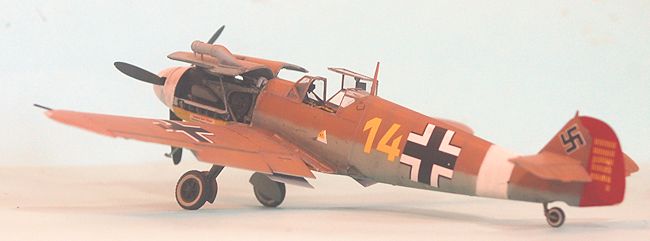 pulled up, turned, and dove on his second victim,
shooting it down also from a range of 150 feet. The others dove away but
Marseille went after them, turning into his third victim and knocked it out in a
dive. Passing through the smoke of
number three, he leveled off at low altitude then zoom-climbed onto the tail of
number four. His cannon did not fire, so he shot this one down with his 7.7mm
machine guns from a distance of 100 feet.
At the moment he hit number four, 15 seconds after hitting number three,
the third victim hit the ground, an indication of Marseille's speed.
The 12 remaining Tomahawks were now at very low altitude, racing for
home. He quickly closed distance, pulling alongside one Tomahawk before turning
and hitting it in the engine and cockpit. He climbed again, selected a target
and hit his sixth victim in a vertical dive.
Now short of fuel and ammunition, he and his wingman, who had witnessed
the entire event, flew back to base.
pulled up, turned, and dove on his second victim,
shooting it down also from a range of 150 feet. The others dove away but
Marseille went after them, turning into his third victim and knocked it out in a
dive. Passing through the smoke of
number three, he leveled off at low altitude then zoom-climbed onto the tail of
number four. His cannon did not fire, so he shot this one down with his 7.7mm
machine guns from a distance of 100 feet.
At the moment he hit number four, 15 seconds after hitting number three,
the third victim hit the ground, an indication of Marseille's speed.
The 12 remaining Tomahawks were now at very low altitude, racing for
home. He quickly closed distance, pulling alongside one Tomahawk before turning
and hitting it in the engine and cockpit. He climbed again, selected a target
and hit his sixth victim in a vertical dive.
Now short of fuel and ammunition, he and his wingman, who had witnessed
the entire event, flew back to base.
In 11 minutes of combat, Marseille had
shot down six victims, five in the first six minutes.
Not a single round was fired at him. When they were debriefed, the
surviving Tomahawk pilots reported they were attacked "by a numerically superior
German formation which made one formation attack at them, shot down six of their
friends, and disengaged". During a
post-war analysis of this dogfight, these pilots again testified the same. The
RAF was reluctant to admit such a devastating defeat, and it was only when Ray
Toliver reviewed the German records and interviewed Marseille's wingman, that
the truth came out.
On September 1, 1942, Marseille had his
greatest day, shooting down 17 RAF fighters in three missions, including eight
shot down in ten minutes on his second sortie of the day.
During the month of September, he shot down 54 enemy aircraft, and was
promoted to Major after becoming the youngest Captain in the Luftwaffe that
August.
 On Sept. 26, 1942, he scored his final
victories, bringing his total to 158 confirmed air victories. He had received a
new Bf-109G-1, but had refused to replace his Bf-109F-4.
His position was such that only a direct order by Feldmarschal
Kesselring, put him in the cockpit of the new fighter.
On Sept. 26, 1942, he scored his final
victories, bringing his total to 158 confirmed air victories. He had received a
new Bf-109G-1, but had refused to replace his Bf-109F-4.
His position was such that only a direct order by Feldmarschal
Kesselring, put him in the cockpit of the new fighter.
On September 30, 1942, Marseille flew
his 382nd combat mission, a fighter sweep over the British lines, during which
no contact was made. As the
formation turned back toward German lines, the cooling system of Marseille's
fighter failed and the engine caught fire.
With his cockpit was full of smoke, Marseille flew the burning fighter
three more minutes until he was over German territory. He rolled upside down and
jettisoned the canopy, then released his harness and fell out of the cockpit.
He was hit in the chest by the horizontal stabilizer as the fighter
immediately entered a dive. Losing
consciousness, he was unable to open his parachute and died on impact.
Posthumously, Marseille was awarded the Diamonds to the Knights Cross, in
addition to the Oak Leaves and Swords he had been awarded previously.
On his grave, his squadron mates put his name and rank, and one word:
"Undefeated."
| THE KIT |
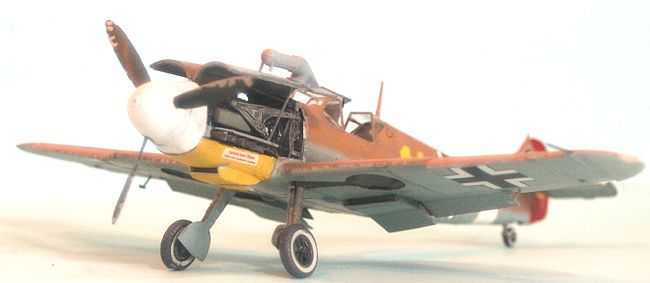
| CONSTRUCTION |
Unlike the recently-reviewed F-101, everything in the Zvezda Friedrich kit fits
(other than the canopy mentioned above) and it is possible if you assemble with
care to not use any seam filler anywhere.
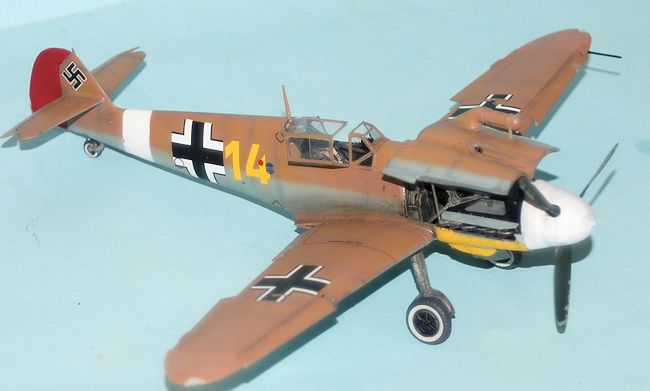
| COLORS & MARKINGS |
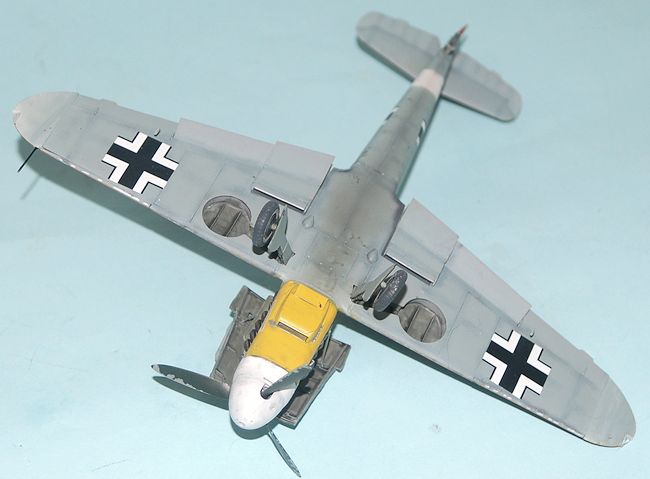
| CONCLUSIONS |
The Zvezda kit does the best of any 1/48 Bf-109 kit to convey the essential
delicateness of the Bf-109. The
model may be "fiddly," but if you follow the instructions the result will be a
very satisfying model. Recommended
for anyone who has built detailed plastic airplane kits.
Thanks to HobbyLink Japan for the review kit. Get yours at this link.
Thanks to Lifelike Decals for the review sheet.
If you would like your product reviewed fairly and fairly quickly, please contact the editor or see other details in the Note to Contributors.